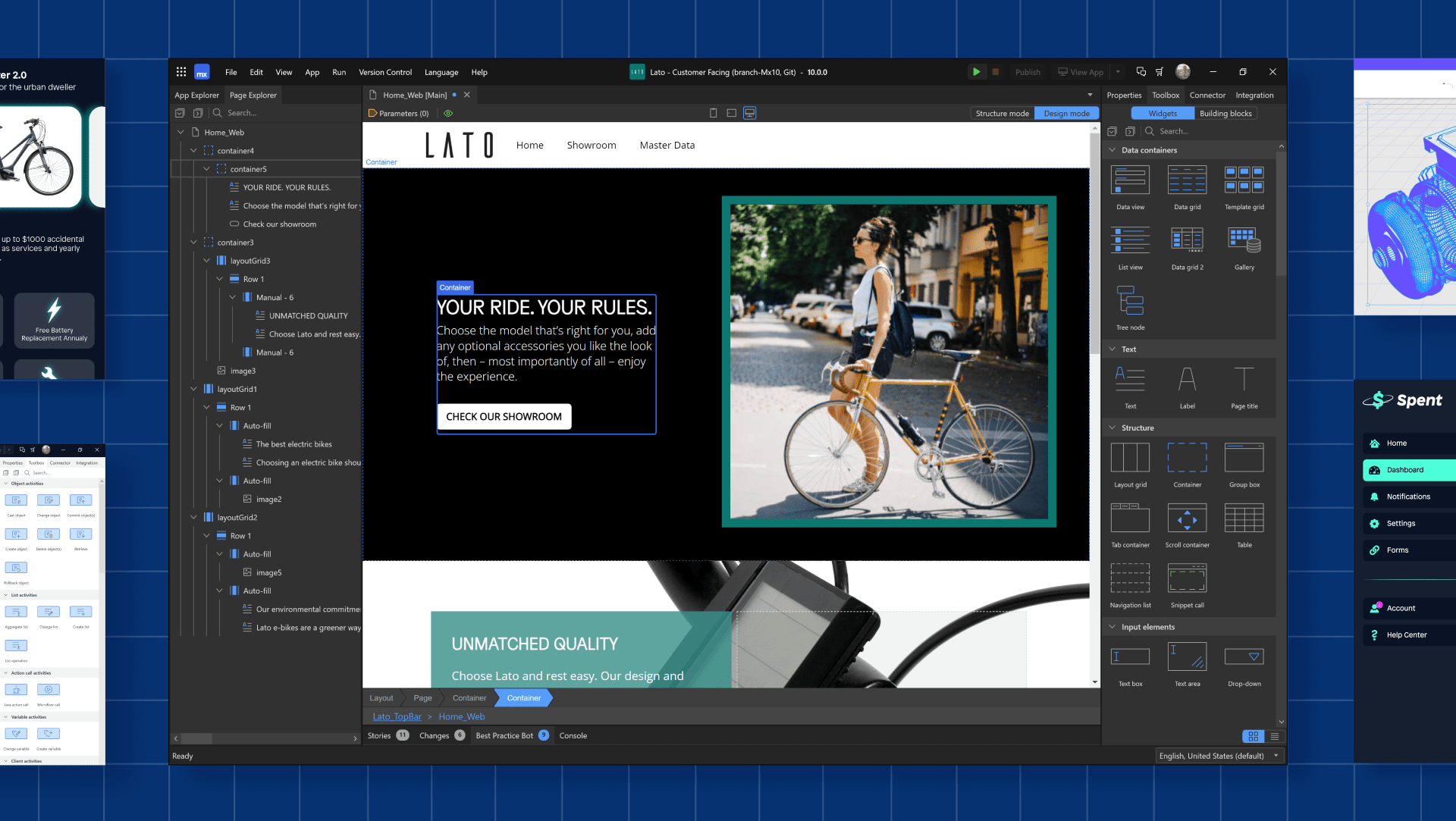
Low-Code Examples and Use Cases
What can you build with low-code application development? Simply answered, a whole lot. From automating manual processes to rebuilding core legacy systems, organizations across every industry are using low-code to build value-driven business solutions with less coding, in less time. Here’s a look at a few of the many examples of successful low-code use cases.
Customer experience

Customer and employee portals
Web-based portals are cost-effective digital tools that deliver self-service experiences, such as submitting claims, paying bills, and generating quotes.
With low-code you can quickly build portals, reuse interfaces, and tailor functionality to specific experiences for internal and external users. Portals built with low-code are also cost-effective and can help organizations add new revenue streams.
Use Case
The City of Rotterdam improves experiences with portals

The City of Rotterdam was facing barriers to digitalization, primarily driven by a gap between the business and IT. This resulted in lengthy development timelines and mounting shadow IT.
To better serve their employees and citizens, the city adopted Mendix in 2018 and has since delivered solutions such as a COVID-response digital service counter, a parking reservation mobile application, and an internal portal to manage incoming subsidies from other municipalities.
The city has expedited delivery by leveraging reusable components, working agile, and empowering citizen developers. Today, the city has delivered 100+ low-code applications supporting over 100,000 users, with an average development timeline of 8-12 weeks.
Native mobile applications and PWAs
Mobile application development can be a complex endeavor with traditional programming languages. But low-code makes it easy to develop fit-for-purpose mobile applications in a single platform – without having to recruit professional mobile developers.
Investing in new digital self-service experiences like mobile applications and progressive web applications (PWAs) can both enhance customer satisfaction and add new business revenue. By leveraging the ReactNative framework, organizations can deliver rich user experiences with cross-platform applications for every user, device, and operating system.
Use Case
Erie Insurance delivers first native mobile application with no mobile developers

Erie Insurance, a Fortune 500 insurer, had a mobile-responsive customer portal but recently identified the need to create a native iOS and Android application to better serve their customers.
The Erie IT team does not employ any mobile-specific developers, so they turned to Mendix to build their first customer-facing native mobile application with no specialized mobile development resources.
Erie’s mobile customer portal has drastically simplified areas of their customer experience. The single application interface includes biometric login and allows customers to quickly and easily access their policy information, payments, and ID cards.
Digital transformation

IoT-enabled applications
Applications built with low-code can integrate with IoT platforms, enterprise systems, and third-party services, providing organizations with data that can be translated into actionable insights for end-user consumption.
Low-code empowers organizations to build rich customer experiences on top of connected devices. Medication temperature monitors, equipment trackers, and service issue alerts are just a few of the many IoT-enabled applications you can build with low-code.
Use Case
WRSTBND increases ticket sales with IoT-enabled turnstiles

WRSTBND, formerly known as Solomon Group, is an entertainment production company specializing in large-scale events. The company was facing challenges streamlining event planning due to manual Excel processes and an ineffective Quickbase application.
The team used Mendix to deliver a series of employee applications — a custom ERP, an application integrated with IoT turnstiles, and an RFID VIP Management application — to save employee hours and deliver new revenue streams.
Implementation of the IoT turnstiles allowed for greater transparency at events for both employees and regulators, yielding a $700,000 increase in single-day ticket sales.
New business models
Core offerings typically include physical products, services, or a combination of both. But in our digital-first world, every organization is also in the business of software.
With low-code, you can build new applications that enhance your core products or service offerings and then make them available to be sold commercially. Not only can your low-code applications solve the most common pain points customers face, but they can also open up new revenue streams and help capture new markets.
Use Case
Collin Crowdfund leads with a lending platform

Colling Crowdfund was conceptualized by two banking veterans to connect entrepreneurs seeking funding with investors looking for new opportunities. However, off-the-shelf platforms could not meet the needs of their new business model.
Using Mendix, Collin Crowdfund built their own fit-for-purpose lending solution, which manages everything from back-office processes to banking transactions to coordinating vetting and approval entities.
Collin Crowdfund now powers their business on an end-to-end low-code lending platform which was delivered in just 5 months and has placed €235,354,500 in loans since its launch.
Legacy modernization


Replace, migrate, or extend legacy systems
There inevitably comes a time when organizations need to address the inefficiencies and faults of antiquated legacy systems. But you don’t have to kick these systems to the curb right away.
From updating business processes to completely rebuilding your core system, low-code is a frictionless way to modernize. If your core system is still functional, you can build modern applications on top of it to extend its capabilities. You could also choose to decentralize your core system by incrementally building replacement applications. Or, if your legacy system is nearing the end of its lifespan, use low-code to completely rebuild, starting with the most vital components.
Use Case
BDC dramatically accelerates loan processing

BDC, a government-owned bank that supports 60,000 Canadian businesses, was facing slow processing times for loan applications due to an aging core system.
Using Mendix, BDC created a new Core Lending System which consolidates
documentation and approvals in the application process. It has over 100 integration points with other applications such as a CRM, a client file system, and external applications such as FICO Blaze Advisor.
The new BDC Core Lending System MVP was delivered in just 4 weeks, and reduced loan processing time to 20-30 minutes; in some cases making funds available for applicants on the same day.
Microservices
Low-code platforms can help phase out monoliths faster with the ability to create microservices, which are application components that serve specific business functions. One application can include hundreds or even thousands of microservices.
With this low-code approach, APIs are used to rearchitect monolithic applications into low-code-based microservices. Deploying updates is fast, easy, and undisruptive to the rest of your system.
Use Case
PostNL speeds parcel delivery with microservices at scale

PostNL is the national postal carrier of the Netherlands, serving 17 million customers and delivering an average of 8.1 million letters and 1.1 million parcels per day.
Their legacy order management system, developed with traditional programming languages, could no longer meet the business demand of PostNL as parcel volume and complexity increased with the rise of eCommerce.
PostNL rebuilt their core order management system with Mendix and implemented a microservices architecture, which now processes over 1 million parcels daily. They also cleared their two-year backlog in six months and offer a 99.95% uptime guarantee.
Process automation

Workflow automation
Replace manual back-office tasks with digitalized workflows. Low-code offers the speed, flexibility, and collaboration tools for developing applications to automate invoice processing, budget requests, approvals, and beyond.
Use Case
PVH Europe automates across the retail supply chain

PVH Europe, the parent company of iconic brands like Calvin Klein and Tommy Hilfiger, needed to extend and customize their SAP instance to fit the company’s overarching strategy of sustainability and efficiency.
With Mendix, PVH Europe tailored SAP to match their business strategy and keep their core clean by developing multiple applications which replace manual processes for managing external employees, processing returns, and global budget tracking.
PVH Europe is saving between one and three FTE savings in manual labor with each application created, driving business value in data accuracy, streamlining compliance, and improving efficiency.
Centralized maintenance platform
Low-code process automation helps streamline all types of enterprise workflows, from simple tasks to sophisticated systems. Connect disparate data sources to your low-code application for a centralized solution that automatically displays historical and real-time information. You can also incorporate advanced technologies like IoT, AI, and machine learning for more accurate forecasting and predictive maintenance.
Use Case
Kaneka Malaysia harnesses manufacturing data to drive automation

Kaneka Malaysia, a manufacturer of vinyl, polymers, foams, and performance fibers, was facing challenges in their manufacturing operations due to a reliance on legacy systems and manual processes conducted in-person, over email, or with Excel.
The team adopted low-code to digitalize their internal operations and improve their quality, reporting, and compliance systems. This resulted in fully digitalized solutions such as a Raw Material Management System and Quality Management System.
Over the course of 18 months, Kaneka rebuilt 55 manual processes and delivered 13 new systems with low-code, yielding 80-100% time savings across various points of the manufacturing process.
Introducing Mendix: The Enterprise Application Development Platform
